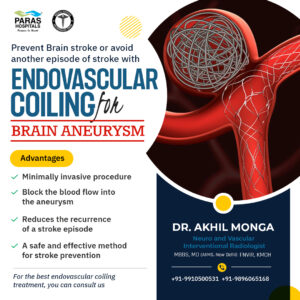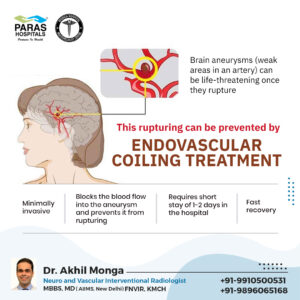



Brain aneurysms are serious medical conditions that can lead to life-threatening complications, including brain aneurysm rupture. Fortunately, advancements in brain aneurysm treatment have made it possible to address these potentially dangerous conditions with less invasive procedures. One such treatment is endovascular coiling for brain aneurysm, which offers a safer alternative to traditional surgical methods, providing quicker recovery and immediate relief.
In this blog, we will discuss what a brain aneurysm is, how aneurysm coiling works, and why it is considered an effective and non-surgical aneurysm treatment.
A brain aneurysm is a weak spot found in the wall of an artery in the brain; it is a bulge developed due to weakened areas that can expand over time. When the aneurysm ruptures, it produces bleeding into the brain, popularly known as a subarachnoid haemorrhage, which is again a life-threatening condition that needs immediate medical attention at the earliest to prevent strokes, brain damage, or sometimes even death.
As a matter of fact, the higher the size of an aneurysm, the more risky the rupture is; this explains why early detection and treatment are so crucial. Thus, endovascular coiling for a brain aneurysm would mean safe and effective prevention against its rupture or the handling of one that has already occurred.
Endovascular coiling is a non-surgical aneurysm treatment used to address both ruptured and unruptured brain aneurysms. Unlike traditional surgical procedures that involve opening the skull, coiling is a minimally invasive procedure performed by a neuro-interventional radiologist. This technique involves the insertion of small platinum coils into the aneurysm to seal it off, preventing further risk of rupture.
The Aneurysm Coiling Procedure is highly effective, especially when performed soon after an aneurysm rupture and is a good preventive measure for unruptured aneurysms that are at risk of rupturing.

Endovascular coiling for a brain aneurysm is performed through a minimally invasive technique. Here's how the procedure works:
This procedure is highly effective, with a success rate that has improved significantly over the years thanks to advancements in technology and techniques.
Endovascular coiling can be used to treat both ruptured and unruptured brain aneurysms. Here’s how the procedure can help:
The best treatment option relies on various factors, like the size, location, and shape of the aneurysm, as well as the patient's overall health.

For patients diagnosed with a brain aneurysm, endovascular coiling is a potentially life-saving treatment with minimal risk, fewer complications, and quicker recovery compared to traditional surgery. Whether the aneurysm has already ruptured or is at risk of rupturing, aneurysm coiling is a proven effective method for the treatment and prevention of further complications. If you are looking for a specialist to treat your brain aneurysm or would like to discuss non-surgical aneurysm treatment options, you should seek a neuro-interventional radiologist.
If you or a loved one has been diagnosed with a brain aneurysm, do not wait. Timely treatment will prevent complications such as the rupture of a brain aneurysm. Dr Akhil Monga is a highly experienced neuro-interventional radiologist with special experience in performing Aneurysm Coiling Procedures and other advanced brain aneurysm treatments. Book an appointment with him and experience a personalised approach and state-of-the-art techniques, assurance of getting the best care.